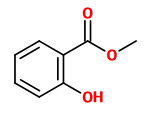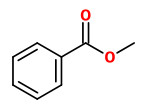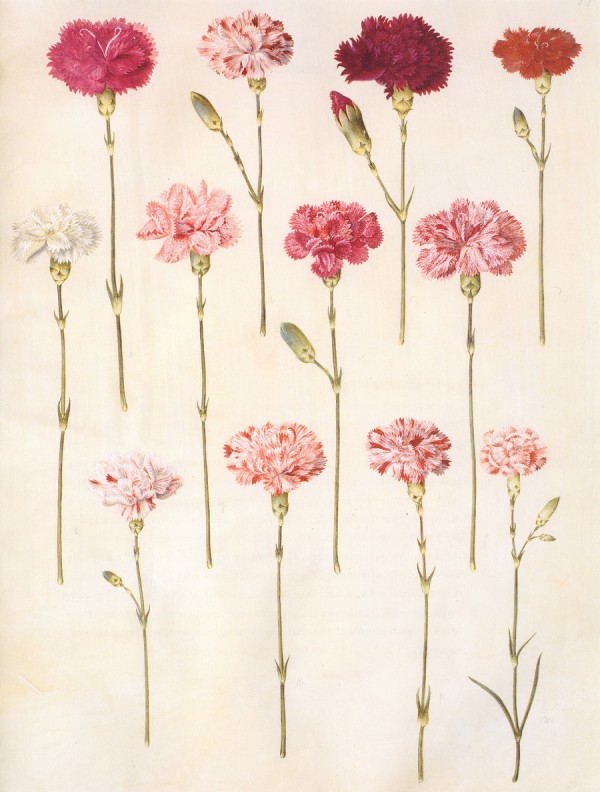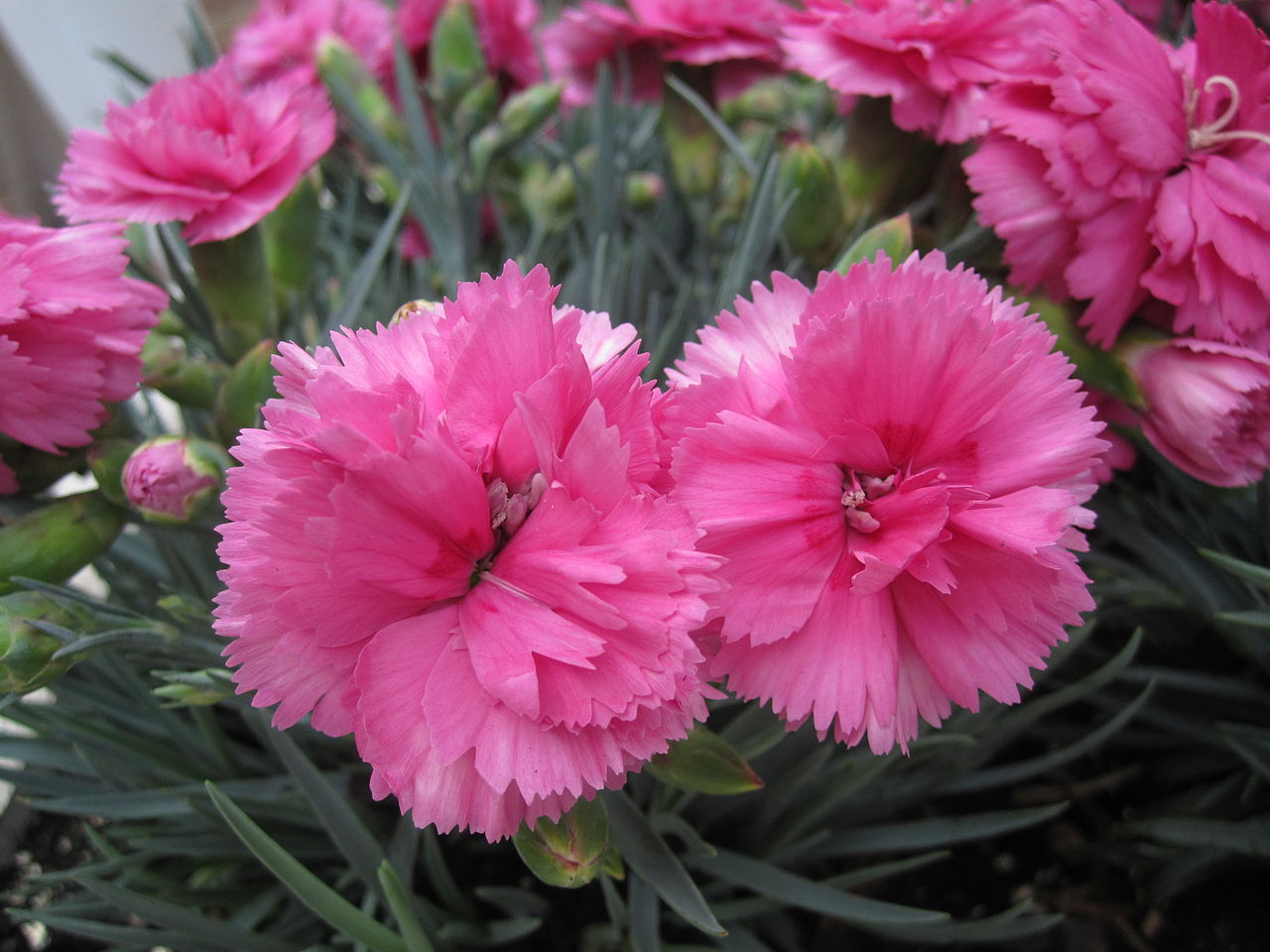Benutzer-Werkzeuge
Dianthus caryophyllus L. - Caryophyllaceae - carnation, Gartennelke, Landnelke
Erect perennial herb, up to 80cm high, native to the Mediterranean, cultivated since ancient times.
„Carnation, Dianthus caryophyllus L., which originated in the Mediterranean countries, holds an important place in perfumery. Southern France, Italy, Egypt, and Kenya are now the main sources of carnation flowers for perfumery use. The flowers are extracted with volatile solvents, yielding carnation concrete, which on treatment with alcohol, gives carnation absolute… Carnation absolute is very expensive, therefore synthetic carnation compounds have been developed, the main components being eugenol and its derivatives combined with salicylates, benzoates and rose components.“
[Anonis, Danute Pajaujis. „The application of carnation in perfumery.“ Flavour and fragrance journal 1.1 (1985): 9-15]
Treff et al. in 1929 disclosed the presence of five constituents in the hydrodistillation product from the absolute of carnation concrete: Eugenol (30%), 2-phenylethanol (7%), benzyl benzoate (40%), and methyl salicylate (1%). Derbesy et al. in 1980 found aliphatic acids C12-C20, citronellol, benzyl benzoate, hexyl benzoate, (Z)-3-hexenyl benzoate and eugenol.
An oil hydrodistilled from a commercial Egyptian hexane concrete contained mainly hydrocarbons C10-C29 (27%), alcohols (29%, C6-C10, linalool, geraniol, nerol, α-terpineol, (Z)-3-hexenol, benzyl alcohol, 2-phenylethanol), and esters like benzyl benzoate (11.8%), benzyl salicylate (1.5%), (Z)-3-hexenyl benzoate (1.1%), and methyl linoleate. Ethers and phenols included eugenol (20.8%) and methyl eugenol, benzylethylether, dibenzylether, (Z)-3-hexenyl benzylether, o- and p-cresol, and 2-methoxyphenol. Aldehydes C6-C10 were only present in minor amounts (1%) but had a great impact on the odour of the top note of the oil. Other oxygenated compounds with special odour impact were vanillin, benzaldehyde (0.9%), jasmone (0.4%), methyl jasmonate (0.01%), (Z)-3-hexenyl (E)-2-hexenoate, and (Z)-3-hexenyl (Z)-3-hexenoate.
An absolute (21.1% yield from the concrete) contained mainly hydrocarbons (20%), a smaller amount of eugenol (3.6%). Contrary to the steam-distilled product, most constituents eluted (GC/MS) after eugenol.
[Buil, P., J. Garnero, and D. Joulain. „Newly identified constituents in concrete from carnation flowers.“ Parfums, cosmétiques, arômes 52 (1983): 45-49]
 eugenol (clove-like) |  2-phenylethanol (rose-like) |  methyl salicylate (wintergreen) |  methylbenzoate (green floral) |
The odor of older varieties of carnation is more spicy (clove-like), determined by eugenol. Most modern varieties produce low levels of eugenol and lack the characteristic fragrance: „The headspace GC/MS analysis of five varieties of perpetual flowering carnations and one Malmaison type showed significant differences in the chemical composition of their flower scent. The principal difference in odor between the varieties was accounted for by the proportion of eugenol (trace-84.1%) and methyl salicylate (0.1-1.4%).“
[An investigation into the scent of carnations. Clery, R. A., Owen, N. E., Chambers, S. F., Thornton-Wood, S. P., Journal of Essential Oil Research, Vol.11(3), 1999, 355-359]
„Thirteen major volatiles of the carnation flower fragrance signature have been identified by GC/MS. Of these, ten, hexanal, (2E)-hexenal, 1-hexanol, 2-hexanol, 3-hexen-1-ol, nonanal, benzaldehyde, benzyl alcohol, benzyl benzoate and caryophyllene, were quantified.“
[Fragrance volatiles of developing and senescing carnation flowers. Schade, F., Legge, R. L., & Thompson, J. E., Phytochemistry, Vol.56(7), 2001, 703-710]
Based on GC-MS analysis, benzoic acid, benzyl benzoate, phenylethyl benzoate, methylbenzoate, (Z)-3-hexenyl benzoate and β-caryophyllene are the major fragrance compounds, representing ca. 60% of the total volatiles generated by Dianthus caryophyllus cv.Eilat flowers.
[Linalool and linalool oxide production in transgenic carnation flowers expressing the Clarkia breweri linalool synthase gene., Lavy, M., Zuker, A., Lewinsohn, E., Larkov, O., Ravid, U., Vainstein, A., Weiss, D., Molecular Breeding, 2(9), 2002, 103-111]

Dianthus caryophyllus L., Gottorfer Codex, (1649-1659)
http://plantgenera.org/species.php?id_species=334734

carnation cultivar garden (2012) Wikimedia Commons, Author: Noordzee23 CC BY-SA 3.0
